- 전체(83)
- 강익중/詩 아닌 詩(83)
- 김미경/서촌 오후 4시(13)
- 김원숙/이야기하는 붓(5)
- 김호봉/Memory(10)
- 김희자/바람의 메시지(30)
- 남광우/일할 수 있는 행복(3)
- 마종일/대나무 숲(6)
- 박준/사람과 사막(9)
- 스테파니 S. 리/흔들리며 피는 꽃(49)
- 연사숙/동촌의 꿈(6)
- 이수임/창가의 선인장(149)
- 이영주/뉴욕 촌뜨기의 일기(65)
- June Korea/잊혀져 갈 것들을 기억하는 방법(12)
- 한혜진/에피소드&오브제(23)
- 필 황/택시 블루스(12)
- 허병렬/은총의 교실(102)
- 홍영혜/빨간 등대(70)
- 박숙희/수다만리(66)
- 사랑방(16)
(419) 강익중: 달항아리가 사람이라면/ If the Moon Jar were a Person
詩 아닌 詩 <21>
달항아리가 사람이라면
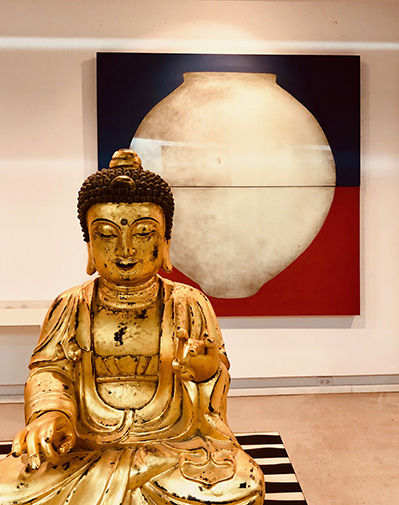
달항아리와 목조 불상, 2018, 6 x 6 ft, 나무 위에 혼합 재료
달항아리가 사람이라면
순수하고 당당한
가을하늘 같은 사람일 것 같다
달항아리가 사람이라면
누구라도 품어주는
큰 산 같은 사람일 것 같다
달항아리가 사람이라면
그늘 아래로 아이들이 모이는
고향의 느티나무 같은 사람일 것 같다
화가들은 주로 사람의 앞모습을 그린다. 뒷모습만 그리는 화가도 있다. 하지만 스페인 화가 피카소는 앞과 뒤를 함께 그렸다. 보이는 면과 보이지 않는 면, 앞과 뒤를 합쳐야 한사람이 되기 때문일 것이다. 위아래가 만나 비로소 하나의 생명으로 피어나는 백자 달항아리를 많이 닮았다.
달항아리를 사람으로 비유하면 목은 짧고 배와 가슴이 큰 모습일 것이다. 도공은 겉이 두껍고 속이 좁은 항아리를 빚지 않고, 자신보다는 남을 품는 소박 하고 겸손한 속이 텅 빈 백자 달항아리를 만든 것이다. 우리는 달항아리에서 볼수록 끌리는 사람, 좀 어리숙하지만 맑고 넉넉한 사람, 작아도 열린 사람을 볼 수 있다.
또한, 달항아리에서 금동미륵반가사유상에서 보이는 편안한 미소를 볼 수 있다. 생로병사의 모든 짐을 다 내려놓을 때 나오는 미소이다. 걸을 때는 걷고, 들을 때는 듣고, 웃을 때는 웃고, 바람 불면 바람에 안기고, 내려놓을 때 내려놓을 수 있는 미소이다. 이 미소의 주인공이 반가사유상을 만들고 달항아리를 빚은 작가 자신의 모습인 지도 모른다.
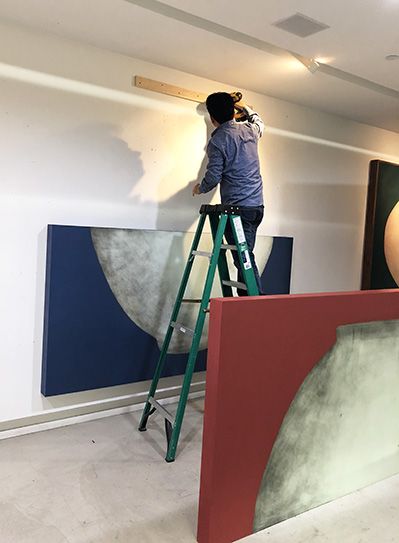
강익중 차이나타운 작업실, 달항아리 빨강 파랑, 2018
백토로 빚어진 조선 시대 달항아리는 무심의 경지에 이른 도공의 숙련된 손에 의해 위와 아래 두 개의 그릇이 서로 포개진 후 뜨거운 불가마에 놓였다. 1,000도가 넘는 불을 통과한 후에야 보름달을 닮은 하나의 몸체로 살아난 것이다. 그 안에는 봄의 새싹이 겨우내 얼어붙은 땅을 뚫고 나오고, 작은 물고기가 물속을 가르며 나아가는 ‘생명성’이 존재한다.
우리가 듣는 이 살아있는 생명, 달항아리의 생명을 들을 때 우리 안에 울림이 전해진다. 그냥 단순한 파장으로서 흘려보내는 소극적인 들음(Hearing)이 아니라 내 안에 있는 울림판을 통해 듣는 적극적인 들음(Listening)이다. 내가 달항아리의 품에 온전히 안길 때 과거와 현재 미래의 시제가 나에게 온전한 울림으로 다가온다. 시간은 어차피 우리가 정해 놓은 약속, 시간은 우리의 생각 속에 존재한다. 시간은 바람처럼 구름처럼 이어져 있다. 시간은 그대로 있다. 저 산처럼 그대로 있고 시간은 이미 내 안에 처음부터 살고 있을지도 모른다.
둘이었다가 온전한 하나의 몸으로 이어져 공명하는 달항아리와 같이 한글도 모음과 자음이 모여 하나의 소리를 만든다. 모음과 자음이 어우러진 후 숨을 불어 넣으면 하나의 완전한 소리가 나온다. 온전히 비어 있으면 안과 밖이 없고 너와 나의 구별이 없다. 하늘이 곧 땅이 되고 밤은 낮이 된다. 그곳에는 소통과 연결만이 있을 뿐이다. 한글과 달항아리는 합쳐야 완성되고 모여야 살아나는 우리 민족의 비밀코드인 셈이다.
2001년 당시 세 살이었던 아들에게 한글을 가르치면서 아이가 모음과 자음을 쉽게 구별할 수 있도록 각기 다른 색의 크레용으로 모음과 자음을 그렸는데 너무 쉽게 한글을 읽어 내려갔다. 그 후 똑같은 방법으로 외국 친구들에게 한글을 가르치며 음과 양의 원리를 설명했는데, 얼마 되지않아 한글을 따라 읽기 시작했다.
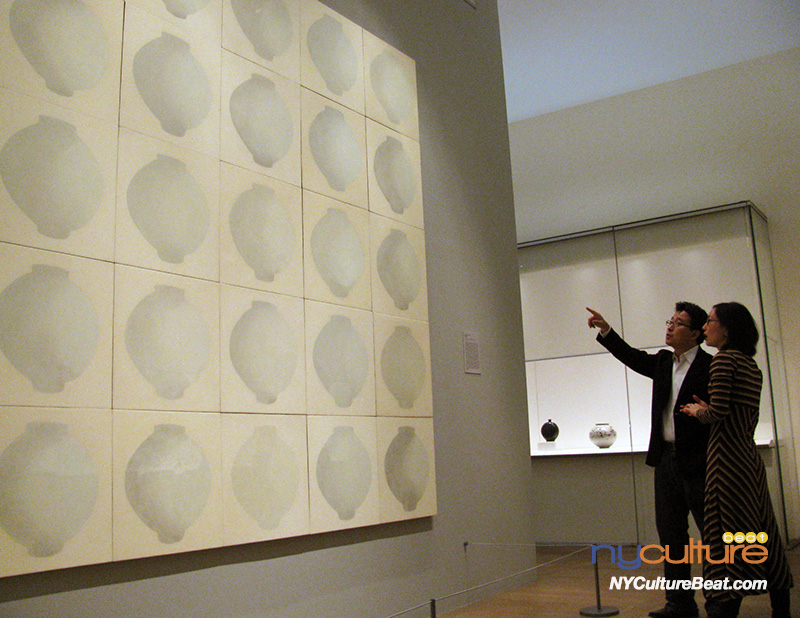
강익중 작가와 이소영 큐레이터가 2009년 11월 메트로폴리탄 미술관 한국실에 전시된 달항아리 연작 '25가지의 소망(25 Wishes)'에 대해 대화를 나누고 있다.
수년 전, 뉴욕 메트로폴리탄 미술관에 백자 달항아리가 전시되었다. 미술관 한편에 놓여 세상에서 모인 보물들과 맞서 있었다. 살며시 보이는 하얀 속살을 보고 ‘그저 맑다’는 말을 함부로 쓸 수 없었다. 그냥 그렇게 살아온 내가 부끄러웠기 때문이다. 넉넉한 흰 치마폭으로 모두를 감싼, 어쩌면 우리 아버지 어머니 그리고 할아버지 할머니의 모습이다. 덩그렇게 놓인 달항아리는 그저 무덤덤해도, 크고 화려하지 않아도 순백의 기품에서 세상을 품고도 남을 만한 넉넉함이 있었다. 미술관에 다녀온 후 달항아리를 한마디로 표현할 단어를 찾느라 며칠을 고민했다. ‘순수 당당’이라는 두 단어 외에는 지금까지 특별한 표현이 떠오르지 않는다.
2004년 일산 호수공원에 지름 15m의 구(球)를 물 위에 띄웠다. 구의 겉에는 전 세계에서 모은 12만장의 그림을 붙였다. 꿈으로 이어진 하나의 지구가 완성되는 순간이었다. 그러나 설치가 끝나갈 때쯤 무리하게 바람을 넣어 구조물이 터지면서 완벽한 구와는 약간 거리가 있게 되었다. 큰일이었다. 실망한 체 한참을 바라보다 무릎을 '탁'쳤다. ‘달항아리다!’
전 세계 아이들의 꿈으로 남북을 잇고 세계를 이으려는 나의 꿈을 알아차린 듯 달항아리가 내 앞에 서 있었다. 한쪽이 약간 기운 완벽한 달항아리의 모습이다. 문득 어릴 때 버스 정류장에서 뒤로 보였던 푸른 하늘, 학교를 마치고 집에 오는 길에 본 저녁노을이 생각났다.
10년 전쯤에는 독일의 미술관에 주최한 ‘전통과 미술’ 이란 토론회에 참석한 적이 있다. 관객에게 ‘한국의 전통이 당신의 작품 속에서 어떻게 표현되었는가?’라고 질문을 받았다. 잠시 생각을 하다 ‘그러면 무엇이 독일의 전통이라고 생각하십니까?’라고 질문을 던졌다. ‘저기 있는 교회의 건축 양식인가요? 아니면 당신이 입으신 옷에 전통이 숨어있나요? 혹시 내가 좋아하는 독일 소시지라고 말할 수 있을까요?’
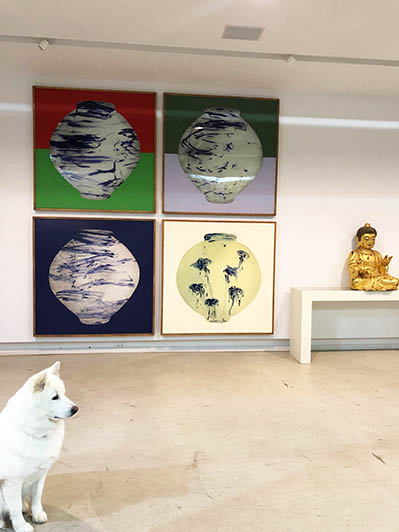
강익중 작업실, 2019, 4개의 달항아리, 47 x 47 in each, 나무 위에 혼합 재료
전통이나 고전이란 단어가 나올 때 오래된 문양이나 의식 또는 절차를 상상하게 된다. 전통은 물건들이 아니라, 생각의 방법이다. 전통은 오래된 글이나 책이 아니라 글과 책 뒤에 숨은 마음일 것이다. 전통은 과거의 흔적이 아니라 미래로 가는 방향이다. 달항아리는 과거라는 뿌리를 통해서 현재라는 줄기와 미래라는 열매로 이어진다. 뿌리도 줄기도 열매도 결국 한 몸인 달항아리와 같기 때문일 것이다.
칠성신을 모시는 제주 무당이 칠성사이다 한 병만을 놓고 굿판을 벌였다는 얘기를 들었다. 자신이 ‘우주의 중심'이라 생각하는 무당에게는 특별한 형식이나 절차는 중요하지 않다. 우리가 자랑하는 비빔밥이 만드는 사람에 따라 들어가는 재료가 달라지는 것처럼 말이다. 밥 한 그릇에 잘 익은 고추장만 있으면 계절과 형편에 따라 어느 것과 어우러져도 맛있는 비빔밥이 된다. 우리가 지니고 있는, 바로 이 ‘유연성’ 이 달항아리에 녹아 있다.
우리의 창호지 문은 안과 밖으로 나뉘어 있지만, 가만히 들여다보면 수없이 많은 구멍으로 열려있다. 달항아리의 울림은 이미 과거인 것 같아도 생각의 주파수를 맞추며 귀를 기울이면 살아있는 풍경으로 우리에게 다가온다. 과거완료 형이 아니라 현재완료 진행형이다. 원래는 둘이었지만 불 속을 뚫고 나와 하나로 합쳐질 바로 우리 민족의 모습일 것이다. 백자 달항아리에는 내려놓음이 있고 사랑이 있다. 용서와 화해가 있고 온전한 태극이 있다.
미워하면
내가 힘들다
놓으면
내가 편하다
용서하면
모두가 산다
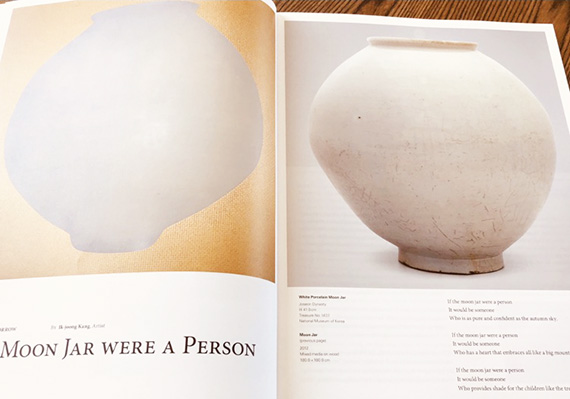
국립박물관(National Museum of Korea) 영문잡지 2019년 봄호에 실린 강익중 작가의 칼럼.
If the Moon Jar were a Person
Ik-Joong Kang
If the moon jar were a person
It would be someone
Who is as pure and confident as the autumn sky.
If the moon jar were a person
It would be someone
Who has a heart that embraces all like a big mountain.
If the moon jar were a person
It would be someone
Who provides shade for the children like the tree from my old village.
Artists usually focus on portraying the front views of people. Some artists portray only the back views of people. However, the Spanish artist Pablo Picasso painted the front and back views of people together. Perhaps he thought that in order to represent a whole person you need to combine the side that shows, the side that doesn't show, the front and the back. This concept is very similar to a moon jar, which comes alive as a single entity when the top and bottom halves are joined together.
If we compare the appearance of a moon jar to a person, it would be someone with a short neck, a wide chest, and a very round belly. The potter does not make a jar that is thick on the outside and narrow inside. But rather he makes a simple and modest white porcelain moon jar that is completely hollow on the inside to embrace others before oneself. In the moon jar we see a person who grows on you, a person who may be a bit rough around the edges, but has a generous and pure heart, a person who may be small but is open-minded.
In the moon jar, we can also see the peaceful smile of a gilt-bronze contemplative bodhisattva. It is the smile that appears when one has let go of all the burdens of life, old age, sickness, and death. It is a smile of someone who walks when it's time to walk, listens when it's time to listen, laughs when it's time to laugh, embraces the wind when the wind blows, and can let go when it's time to let go. It may be that this smile belongs to the artist who made the gilt-bronze contemplative bodhisattva or the moon jar.
The white porcelain moon jar of the Joseon Dynasty is made with white clay. The highly skilled potter combines the top and bottom halves of the moon jar and places it in the fiery kiln through the fire. It isn't until the moon jar bakes at about 1000 degrees celsius does it come alive as one unit resembling the full moon. Inside, the jar holds the vitality that enables new sprouts of spring to push their way through the frozen winter ground, and for small fish to cut across the water.
When we listen to this life force, the life force of the moon jar, the sound resonates within us. It is not the passive "hearing" that lets sounds pass as simple wavelengths, but the active "listening" where the sound is heard through the soundboard within. When I am fully embraced by the presence of the moon jar, the past, present, and future come to me as a single sound. Time is like the promises that we have set. Time exists inside our thoughts. Time is connected like the wind and the clouds. Time stands still. Like that mountain, it stands as it is, and it may be that time has always been inside me.
Like the moon jar that resonates when the upper and lower halves are joined together to become one whole, hangul makes a sound when the consonants and vowels are joined together. Only after they are connected, and you breathe into them you can make a whole sound. In a complete void, there is no distinction between inside and outside or between you and me. The sky becomes the ground and night becomes day. Only connection and communication exist. Hangeul and the moon jar are like the secret code of the Korean people, who are complete when united and who come to life when gathered together.
In 2001, when I was teaching my three-year-old son how to read Korean (hangul), I drew the vowels and consonants with different colored crayons so that he could distinguish them easily. And that is what my son did, he read it so easily. Later, using the same method, I taught some of my non-Korean friends how to read hangul, explaining the principles of yin and yang. Not long after they were reading Korean, too.
Some time ago, a white porcelain moon jar was on display at the Metropolitan Museum of Art in New York. Placed along one of the exhibition walls, it had to compete for attention with treasures from all over the world. Looking at its white inner skin discreetly revealed, the words "It's simply so pure" could not be uttered without care. I was ashamed of myself for having lived without really thinking about it. The moon jar may be like our fathers, mothers, grandfathers, and grandmothers who envelop everyone in their broad white skirts. The round moon jar just sits there in silence. It is not big or fancy, but it emanates the dignity of pure whiteness and the big-heartedness that embraces the whole world with ease. After visiting the museum to see the moon jar, over the next few days I thought hard about how to describe the moon jar in a single word. The best I can do was describe it in two words, "pure and proud."
In 2004 I floated a globe with a diameter of 15 meters on the water at IIsan Lake Park. The surface of the globe was covered by 120,000 children's drawings from around the world. At that moment, the world joined by dreams was about to become complete. However, during the final stages when we were putting the finishing touches on the installation, too much air was pumped into the globe. It ended up bursting and as a result, we ended up with a less than perfect globular shape. What could I do at this point? Disappointed, I was staring at the globe for a very long time and then it suddenly came to me. I slapped my knee and yelled out, "It's a moon jar!"
The moon jar was standing right in front of me, as if it had recognized my dream of uniting North and South Korea, bringing the world together through the dreams of children. It was the perfect moon jar, slightly sunken in on one side. Suddenly I thought of my childhood, the blue sky seen behind the bus stop and the sunset seen from the road on my way home from school.
Ten years ago, I participated in a discussion on the topic of "tradition and art" organized by a German art museum. A member of the audience asked me, "How is Korean tradition expressed in your art?" I thought for a moment, then asked back, "What do you think of as Germany's tradition? Is it the architectural style of that church over there? Or is tradition hidden in the clothes you are wearing? Or would you say it's the German sausages that I like so much."
When the words "tradition or "classical" come up we tend to imagine old patterns, rituals or processes. Tradition is not about material things, but a way of thinking. Tradition is not an old piece of writing or book, but the thinking behind that writing or book. Tradition is not the traces of the past, but the way to the future. Through the roots of the past, the moon jar grows the stem of the present to produce the fruits of the future. The roots, stem, and fruits are ultimately one, like the moon jar.
I heard about a shaman on Jeju Island who served the Seven Star God (Chilseongsin) and held rites for the deity with just a bottle of Chilsung cider (lemon soda pop, “chilsung" pronounced the same as "chilseong") as an offering. For the shaman, who believes she is the center of the universe, following a particular form or process is not important. It is like the way bibimbap, the culinary pride of Korea, varies according to the different ingredients each person uses. A bowl of rice and some well-matured red pepper paste mixed with any seasonal ingredients make for a tasty bowl of bibimbap. It is this flexibility in us that is embedded in the moon jar.
Traditional latticed doors covered with paper divide the inside and outside but if you look at them carefully you will see that they are open with countless little holes. The resonance of the moon jar may seem to be already in the past, but if you tune your thinking and listen carefully it comes across as a living landscape. Not as the past perfect but the present perfect continuous tense. Though originally two, the moon jar is a portrait of our people who will make their way through the flames to emerge united as one. The white porcelain moon jar knows about letting go and love. It represents forgiveness and reconciliation, and the perfect great absolute (taegeuk), the oneness before duality.
If I feel hatred
Life is harder for me
If I can let go
My mind is at ease
If I can forgive
There is a spot for everyone
*강익중씨 런던 템즈강에 '꿈의 섬(Floating Dreams)' 설치
*An Interview with Ik-Joong Kang, Inside Korea(The New York Times)








